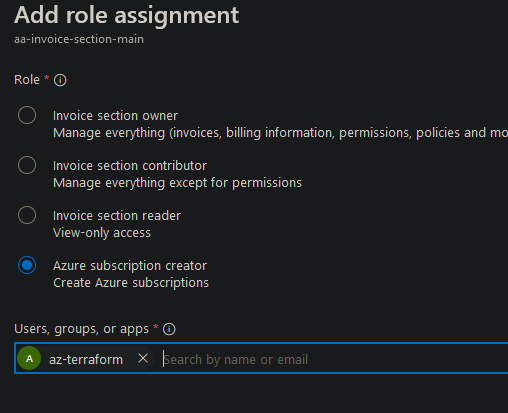Create PayAsYouGo Azure Subs Using Terrform
Description
One of the first things I wanted to show after creating an organization in Github is how to configure Azure completely via IaC, with little to no clicking in the GUI. Well the first step to do that is to create subscriptions. I was certain that you could not do that with “Pay as You Go” types, but sure enough, it’s one of the options!
Note: You can see the code for this post on my Github repo.
Steps
-
The first thing I did was give my Service Principal rights to create subscriptions at the correct “Invoice Section” level:
-

-
It can be confusing the hierarchy, but thankfully the docs cover this well. It’s just Billing Account => Profile => Invoice Section.
-
-
So before using Terraform to create new subscriptions, you have to get the
idproperty of your Billing Account, Billing Profile, and Invoice Section. This tripped me up so bad because the Terraform docs saybilling_nameas in thenameproperty so I don’t have to expose theidfor the world to see, but NOPE, that won’t work! It has to be theid. So confusing! In hindsight looking at the example does show ID values instead of name values.- Anyhow, once you get them, just plug them in to your data source and then run your apply.
-
What happens is, the first two subscriptions created almost instantly, but the third one timed out. I can’t find the logs or I would show you :/
-
I already knew the fix for this from dealing with it in the past, basically you just have to wait. This is because Microsoft doesn’t want customers spinning up hundreds of subscriptions per hour because a subscription is a high level billing resource that holds many things, pretty much the highest level you go on a daily basis so they throttle it. Anyways, I was going to wait 24 hours, but I just re-ran the same pipeline about 12 hours later and it worked.
-
So there you go, you can create PAYG subscriptions using Terraform pretty easily these days. In the past, I always did these by hand and then used terraform to place them in correct management groups but now I can control the subscription objects themselves.

Comments